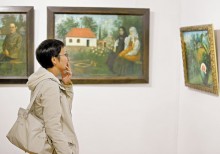This exhibition is the first to be held as part of the “Ukrainian Naive Art of the 20th Century project, developed as a series of artistic events and public lectures aiming to expand the boundaries of perception of the Ukrainian naive art. The name of the exhibition is taken from French writer and critic Louis Aragon’s praise of artist Henri Matisse, who “preserved the sunshine for the young” in difficult times. Indeed, the works of amateur artists on display were created mostly in the harsh 1920s, the hungry 1930s, and the war-riven 1940s, but they still are full of a variety of colors and motifs.
Analyzing paintings by Panas Yarmolenko and Maria Prymachenko, artist Arsen Savadov told the present that to achieve such levels of reflection, one had to master cultural experience and heritage of the nation. “Prymachenko’s works suggest that the ideological programs of the time, terribly Marxist as they were, could not kill the creative reflection of the artist in relation to the main variables of our reality: space, sun, sky, and water. Prymachenko’s images, especially those in animalist paintings of 1937, are very scary-looking, scarier than Joseph Stalin himself, but they are presented in audience-friendly aesthetics. This reflects the canons of true art.”
The exhibition presents works by artists who are less known than Kateryna Bilokur, Maria Prymachenko or Panas Yarmolenko. In particular, flower paintings by Paraska Vlasenko and Sofia Melnyk-Homeniuk, feast-themed sketches on glass by Anastasia Rak (Happy Easter! and Carol Singers with the Star), exaggerated portraits by Tetiana Pata, landscapes by Yaryna Homeniuk and Anton Shtepa, and authentic Ukrainian house paintings by Maria Nelep (Kosohon) show how perceptions of everyday life can differ and how sincere can be the artist’s reflection on it. Even works by Ivan Lysenko, which look made-to-order at the first glance, are equally strong in their creative rethinking efforts: collective portrait Dmytro Mykula’s Family (1933) was based on a photograph of a family killed during the Holodomor, while portraits of uniformed soldiers immediately bring to mind the need to honor the war victims.
“‘The Preserved Sunshine’ presents purity and goodness, uncovered by artists in difficult times,” Petro Honchar, co-organizer of the exhibition and director-general of the National Center of Folk Culture Ivan Honchar Museum, said. “In an age of blood and national disasters, when even survival was not assured, artists still kept hoping. The current events in Ukraine are naturally resonating with the exhibition’s theme, which is the people becoming self-aware. As these artists asserted themselves through their creativity, the Ukrainians are asserting themselves now in fighting for the Donbas. The two phenomena are very similar, and the weapon of art is more powerful than bullets, because it has the whole world of fine arts to back it up and because it is very sincere.”
The works on display include also original interpretations of well-known paintings, such as Mona Lisa by Heorhii Maliavin (watercolor on box cardboard), which reflect their authors’ ideas of recognized masterpieces of art. Besides, the exhibition includes artistic carvings by Yosyp Petruk and Ananii Bolsunovsky and sculptures by Stanislav Sertsevych. Co-organizer of the project Lidia Lykhach told us that folk art and naive art are not one and the same, as the moment of transferring folk ornaments on the canvas was the moment of transition from the folk tradition to the naive art, when amateur masters created their works, full of life and strong in spirit, amid really hard time.
“This exhibition shows how we look when our souls are at their purest,” writer and publisher Ivan Malkovych stated.
“The Preserved Sunshine” will be on display until October 31.








